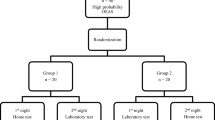Abstract
Six infants were referred with symptoms and clinical signs suggesting airway obstruction during sleep. In each case, overnight recordings of arterial oxygen saturation, respiratory movements and end tidal expired carbon dioxide (ETCO2) showed the presence of abnormal episodes of hypoxaemia related to partial or complete airway obstruction and associated with a specific pattern of the inspiratory movement waveforms. These events and patterns were not found on recordings from 20 age-matched healthy infants and young children. ETCO2 levels were also abnormally elevated in all six patients when asleep. Fiber-optic upper airway endoscopy excluded structural abnormalities, including significant tonsillar or adenoidal enlargement, but showed an intermittent dysfunctional inspiratory obstruction in the pharynx. Continuous positive airways pressure and tracheostomy were effective in treating this obstruction.
Similar content being viewed by others
Abbreviations
- CPAP:
-
continuous positive airways pressure
- ETCO2 :
-
end tidal carbon dioxide
- SaO2 :
-
arterial oxygen saturation
References
Brouillette RT, Thach BT (1979) A neuromuscular mechanism maintaining extrathoracic airway patency. J Appl Physiol 46:772–779
Brouillette RT, Fernbach SK, Hunt CE (1982) Obstructive sleep apnea in infants and children. J Pediatr 100:31–40
Bryan AC, Wohl MEB: Respiratory mechanics in children. In: Cherniak NS, Widdicombe JG (eds) Handbook of physiology, vol 3. The respiratory system, pp 180–183
Carse EA, Wilkinson AR, Whyte PL, Henderson Smart DJ, Johnson P (1981) Oxygen and carbon dioxide tensions, breathing and heart rate in normal infants during the first six months of life. J Dev Physiol 3:85–100
Findley LJ, Wilhoit SC, Suratt PM (1985) Apnea duration and hypoxaemia during REM sleep in patients with obstructive sleep apnea. Chest 87:432–436
Furlonger BJ (1982) High kV filtered beam technique for demonstrating bronchial situs. Radiography 48:197–199
Guilleminault C, Hill MW, Blair Simmons F, Dement WC (1978) Obstructive sleep apnea: electromyographic and fiber optic studies. Exp Neurol 62:48–67
Guilleminault C, Blair Simmons F, Motta J, Cummiskey J, Rosekind M, Schroeder JS, Dement WC (1981) Obstructive sleep apnea syndrome and tracheostomy. Long-term follow-up experience. Arch Intern Med 141:985–988
Hoffstein V, Zamel N, Phillipson EA (1984) Lung volume dependence of pharyngeal cross-sectional area in patients with obstructive sleep apnea. Am Rev Respir Dis 130:175–178
Jeffries B, Brouillette RT, Hunt CE (1984) Electromyographic study of some accessory muscles of respiration in children with obstructive sleep apnea. Am Rev Respir Dis 129:696–702
Martin RJ, Pennock BE, Orr WC, Sanders MH, Rogers RM (1980) Respiratory mechanics and timing during sleep in occlusive sleep apnea. J Appl Physiol 48:432–437
Onal E, Lopata M, O'Connor T (1982) Pathogenesis of apneas in hypersomnia — sleep apnea syndrome. Am Rev Respir Dis 125: 167–174
Onal E, Lopata M (1982) Periodic breathing and the pathogenesis of occlusive sleep apneas. Am Rev Respir Dis 126:676–680
Onal E, Leech JA, Lopata M (1985) Relationship between pulmonary function and sleep-induced respiratory abnormalities. Chest 87:437–441
Pack RJ, Widdicombe JG (1984) Amine-containing cells of the lung. Eur J Respir Dis 65:559–578
Prechtl HFR (1974) The behavioural states of the newborn infant (a review). Brain Res 76:185–212
Remmers JE, Groot WJ de, Sauerland EK, Anch AM (1978) Pathogenesis of upper airway occlusion during sleep. J Appl Physiol 44:931–938
Richards JM, Alexander JR, Shinebourne EA, Swiet M de, Wilson AJ, Southall DP (1984) Sequential 22 hour profiles of breathing pattern and heart rate in 110 full-term infants during their first 6 months of life. Pediatrics 74:763–777
Sanders MH, Rogers RM, Pennock BE (1985) Prolonged expiratory phase in sleep apnea. A unifying hypothesis. Am Rev Respir Dis 131:401–408
Southall DP, Talbert DG (1987) Sudden alveolar atelectasis apnoea braking syndrome. In: Hollinger MA (ed) Current topics in pulmonary pharmacology and toxicology. Elsevier, New York, pp 210–281
Southall DP, Bignall S, Stebbens VA, Alexander JR, Rivers RPA, Lissauer T (1987) Pulse oximeter and transcutaneous arterial oxygen measurements in neonatal and paediatric intensive care. Arch Dis Child 62:882–888
Sullivan CE, Issa FG, Bethon-Jones M, Eves L (1981) Reversal of obstructive sleep apnoea by continuous positive airway pressure applied through the nares. Lancet I:862–965
Wilson AJ (1985) A tape recorder multiplexer for 16 channels. Electronic Eng 57:40–47
Wilson SL, Thach BT, Brouillette RT, Abu-Osba YK (1980) Upper airway patency in the human infant: influence of airway pressure and posture. J Appl Physiol 48:500–504
Author information
Authors and Affiliations
Rights and permissions
About this article
Cite this article
Southall, D.P., Croft, C.B., Stebbens, V.A. et al. Detection of sleep associated dysfunctional pharyngeal obstruction in infants. Eur J Pediatr 148, 353–359 (1989). https://doi.org/10.1007/BF00444133
Received:
Accepted:
Issue Date:
DOI: https://doi.org/10.1007/BF00444133




